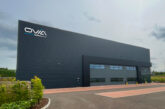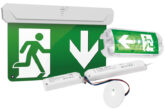
Richard Raeburn, Senior Application Engineer at Tridonic, looks at why battery technology should be one of the key considerations when selecting emergency lighting.
The most usual form of emergency lighting in the UK is a self-contained emergency luminaire, rather than those with a central battery system which are more prevalent in mainland Europe. These widely used luminaires contain the lamp control gear plus an emergency inverter (these can be combined into a single combo unit) which will have its own batteries and LED status indicator.
The battery within the unit will, in most cases, be either Nickel Cadmium (NiCd) or Nickel Metal Hydride (NiMH), each of which has its benefits and drawbacks. However, the latest Lithium Ion (Li-Ion) battery could offer considerable benefits over both of these traditional alternatives. But how do they compare?
NiCd battery technology
These batteries have a long shelf life, are available in a wide range of sizes and performance options and have a good load performance. On the down side, they require periodic full charge (self-discharge rate is 10-20% per month), they have a low specific energy compared to new options available and the presence of cadmium means spent batteries can’t be disposed of in landfill.
NiMH battery technology
These have over double the capacity of a similar sized NiCd cell and are less prone to memory effect; however they’re far less effective at low temperatures and have a high self-discharge level, resulting in a limited service life. When it’s time to replace them they benefit from the fact that they’re easily disposed of and the nickel content can make it profitable to recycle used units.
Li-ion battery technology
This is the newest battery option for emergency lighting and lithium, the lightest of all metals, offers several advantages. Firstly, its high specific energy and high load capabilities within power cells. This, combined with long cycle and an extended shelf life, its low internal resistance and its low self-discharge and reasonably short charge times make it an attractive alternative.
However, there are limitations, namely it requires a protection circuit to prevent thermal runaway if stressed, it will degrade at high temperatures and when stored at high voltage and no rapid discharge is possible at freezing temperatures. On a practical level the stringent transportation regulations that need to be applied when shipping larger quantities need to be taken into consideration.
Detailed testing
The selection of a new battery – be it for emergency or other lighting applications – is a long and complex process that involves detailed testing that encompasses chemical analysis, CT scan, anode reserve measurements, breakdown analysis and calorimetry testing. Even when a suitable alternative battery has been identified, further approvals are required before the selected unit can finally become an integral component of a new emergency lighting product.
To be confident we recommend that you use emergency units that have gained ICEL (Industry Committee for Emergency Lighting) 1010 accreditation. To achieve this a company must be approved to ISO 9001 and provide evidence through testing that the battery cell meets certain minimum requirements e.g a four-year lifetime plus charge/discharge compliance.
Are you ready?
Tridonic has recently launched the EM ready2apply (EM R2A) (pictured below), an ‘out of the box‘ emergency lighting solution that gives installers a product that combines advanced battery technology with the latest in emergency lighting components.
For more information about Tridonic’s EM 2RA emergency lighting solution visit: www.tridonic.com










